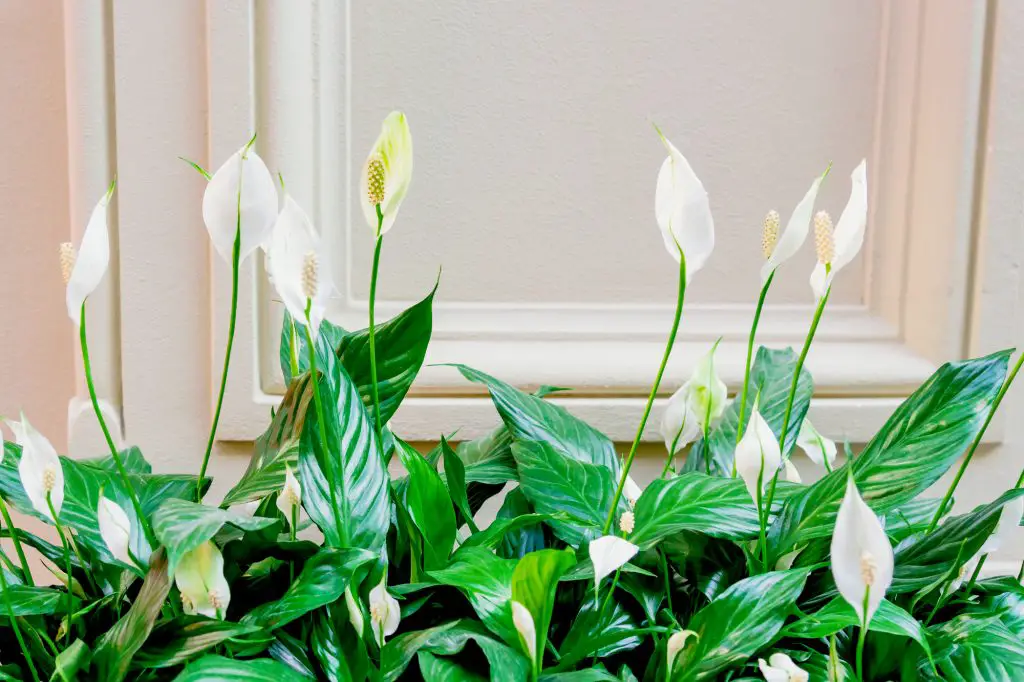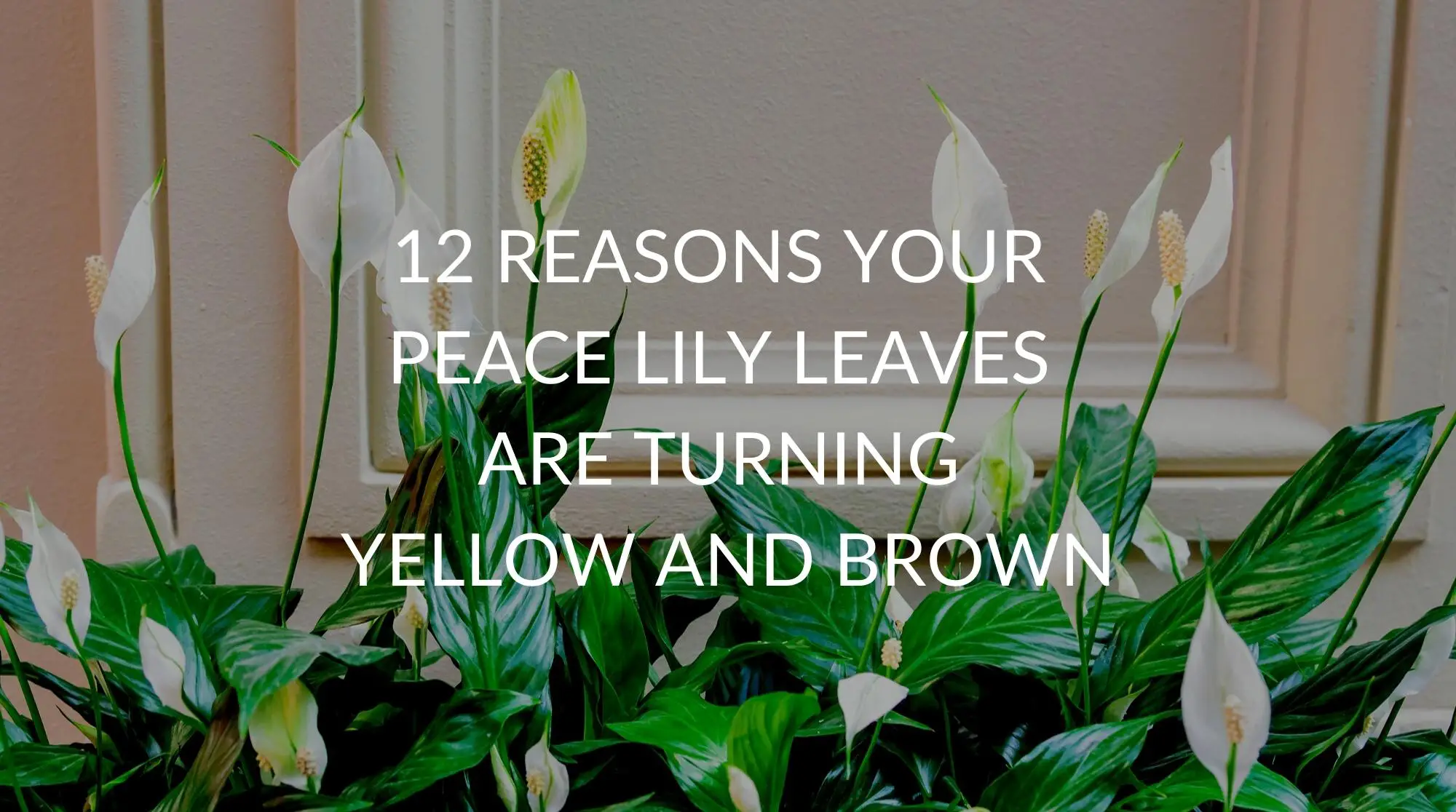Nothing is more disheartening than seeing your peace lily leaves turn yellow and brown. Especially when you think you’ve been giving them so much time and attention. In this article, not only will you find out why your peace lilies leaves are turning yellow and brown, but also, what you can do to fix the issues!
So keep reading to find out everything you want to know!
Why Do Peace Lily Leaves Turn Yellow And Brown?
There are a whole bunch of reasons that your peace lily leaves could’ve turned yellow and brown, and in general, you can stop it happening by making sure your peace lily is getting the best care possible. Here are all the things you might have missed:
Poor Lighting Conditions
One common reason that your peace lily leaves might be turning yellow/brown is due to poor lighting conditions. And poor lighting doesn’t just mean that they’re not getting enough light, but it could also mean that they’re getting too much light as well.
If you notice that your leaves are browning because of the light, then the chances are it’s that they’re being scorched. And if you notice that they’re turning yellow, then they’re either getting too much light or not enough. So you’ll have to check their location to decide.
Temperature Issues
If your peace lily is in an environment where the temperature is too hot it can often turn the leaves brown or yellow. This is most likely because too much transpiration and evaporation occur. Likewise, when it’s too cold, your peace lilies are going to go into a kind of resting mode to conserve nutrients, which can also result in a leaf color change.
Watering Problems
Another reason that your peace lilies may end up turning yellow or brown is that you’re not watering them correctly. Both underwatering and overwatering can cause your peace lilies eaves to turn yellow and brown.
Typically the longer they go without water the darker they’re going to get. If you catch your peace lilies leaves turning yellow, then the chances of recovery are higher than if they start to go brown.
Another typical sign of underwatering is that your peace lilies leaves may begin to curl or drop off altogether, as your peace lily attempts to reduce transpiration.
Drainage Issues
Even if you’re watering your peace lily the perfect amount, if you have drainage problems then it’s not going to matter. You’re still going to be dealing with a plant that may end up being overwatered or underwatered.
Low Quality Water
As well as watering problems, it could be that you’re using low-quality water for your peace lilies. This is especially true if you’re just using water straight from the tap. This water will contain chemicals such as fluoride and chlorine which aren’t good for your peace lily can often build up within the soil.

They’re Not Getting Enough Nutrition
While your peace lily doesn’t need to be fertilized very often, it doesn’t mean they don’t need to be fertilized at all. If your peace lily isn’t getting enough nutrition then they are going to start turning yellow and brown.
More specifically, you may notice that the leaves start to turn yellow, while the veins stay green. If the leaf, in general, is turning yellow then it’s most likely caused by a lack of nitrogen, and if only the tips start to yellow, then it’s going to be caused by a lack of potassium.
They’re Rootbound
Another common reason that your peace lily leaves could be starting to turn yellow or brown is that they’re root bound. While peace lilies do like to be rootbound this is only to a point. If you notice that your peace lilies’ roots are sticking out the surface of the soil, or they’re poking through the drainage holes, then it’s definitely time to move them.
Pests
When pests start to feed off your peace lilies leaves, it can often cause them to wilt and change color, especially in the areas the pests have been feeding. And while it isn’t extremely common to find pests on your peace lilies, it’s definitely possible.
Some pests that may affect them include aphids, mealybugs, whiteflies, and thrips.
Leafspot
If you notice that the brown and yellow appear on your peace lily as rings, then it could be that they’re suffering from leaf spot. If this is the case, you’ll notice that the rings appear brown on the inside before becoming yellow closer to the outside.
Root Rot
If you notice that your peace lily has started to turn yellow and brown then they could also be suffering from root rot. Another symptom you may notice if they are is that the leaves are starting to fall off. However, the only real way to know for sure is to check the roots to see if they’re rotting or not.
(Here’s a full article explaining everything there is to know about root rot in peace lilies.)
Transplant Shock
If you’ve recently transplanted your peace lily, then this could also be causing the peace lily to turn yellow or brown. However, it won’t happen straight away. Genuinely speaking transplant shock normally happens a few days after you’ve transplanted your peace lily.
They’re Aging
Sometimes peace lily leaves just turn yellow or brown as they begin to age. Unfortunately, this is just a natural part of your peace lilies aging process, and there’s not actually a lot you can do about it.
What To Do If Your Peace Lilies Leaves Are Becoming Yellow And Brown?
Fortunately, if your peace lilies leaves are becoming yellow and brown, there are a few things you can do to remedy it! And with the right care, as long as the damage hasn’t spread too much, they can often return back to normal!
Here are all the different things you should do!
Make Sure The Lighting Is Perfect For Them
One of the first changes you should try is making sure that your peace lily is getting the perfect amount of lighting! When you’re choosing a location for your peace lily, you should place your hand in front of the light source and look at your shadow.
If you notice that your shadow is really dark, then that spot is too bright for your peace lily. If you notice that your hand barely makes a shadow, then that spot is going to be too bright.
And in cases where you don’t want your peace lily in sunlight at all, it is possible to use artificial light, but your peace lily will need about 16-18 hours of it a day.
(Find out more about the ideal light conditions for your peace lily!)
Get The Watering Correct
As well as good lighting, you should also make sure that you’re watering your peace lily just right. Again too much or too little are both bad. Fortunately, the trick to knowing whether your peace lily needs water or not is just as simple as finding the perfect light for them.
To check if they need watering, poke your finger into the soil. If you notice at the first knuckle the soil is moist, they don’t need to be watered just yet, but if you notice the soil is dry, then it’s time to water them again!
Keep The Temperature Perfect
You should also make sure that you’re keeping the temperature as close to perfect as possible. Anything between 68-85°F is the ideal temperature for your peace lilies, however, you should also remember to keep them away from any temperature fluctuations as well.
Placing your peace lily near open windows, a fire, radiator, or air conditioning unit can all cause massive temperature fluctuations which can damage your peace lily.
Make Sure You’re Using The Right Pot And Soil Mix
As well as watering them, you should also make sure you’re using the right pot and soil mix to ensure the soil holds water for the right length of time! When choosing a pot you should make sure the drainage holes at the bottom aren’t blocked, and if you’re placing it in a saucer you’re removing the water regularly.
When it comes to the soil mix, you also want to ensure that your peace lilies soil isn’t too tight or loose. As once again this can cause problems for your peace lily.
(Here’s everything you need to know about the perfect soil mix for peace lilies.)
Avoid Using Tap Water…
…Right away. You should also allow any tap water you use to sit for 24 hours so the chemicals inside it have time to dissipate. This way they won’t sink into the soil and damage your peace lily in the future.
If you don’t want to use tap water, it’s also possible to use rainwater or distilled water to water your peace lilies as well. However, the latter would start to become expensive over time.
Flush The Soil
If you think that the soil is holding too many chemicals, salts, and even fertilizer, then it is possible to flush the soil. Doing this will help dilute them as well as drain them out. If you think you should flush your soil, then you should do the following:
- Allow the soil to dry to the point your peace lily is just about to wilt.
- When it gets to this point, pour water through the soil, but not enough for it to start draining out the bottom.
- Then let the water sit for 20 minutes while the soil absorbs it all.
- After 20 minutes, pour more water through the soil, and allow it to drain out the other side.
- Once you’ve done this not only will the water be draining out, but all the chemicals will be as well!
Treat The Root Rot
If you think that your peace lily is suffering from root rot, then of course you’re going to need to treat it! To be sure that it’s root rot, you will need to remove them from the soil to check the roots. If you notice the roots are rotting, then you’ll need to cut them off, disinfect them, and place your peace lily in a new pot with fresh soil.
(Here’s a complete guide to treating root rot in your peace lily.)
Remove Any Pests
The easiest way to remove pests from your peace lily is to do so by hand. But this only works when there’s a couple. If you think that your peace lily has been infested with pests then you should try one of the following:
- Mix some soap with water (make sure it isn’t dishwasher soap, scented soap, or detergent.) Once you’ve done this spray it liberally over your peace lily, making sure to include the underside of your plant as well.
- Or you can also try mixing a teaspoon of neem oil with a cup of water. Once again spray it over your peace lily, making sure to coat the underside once again.
- If you notice that pests are coming and going, you can also place double sided tape down around the pot, for them to get stuck too as well.
Treat Leaf Spot
As well as the pests and root rot listed above, if you think that your peace lily is suffering from leaf spot, then you’re also going to need to treat that as well. To treat leaf spots, you’ll need to remove any infected parts of your plant. As well as this, you should use copper soap to reduce the chances of other areas becoming infected, as well as repotting your peace lily as well.
Fertilize Them When Neccessary
While it’s not always necessary to fertilize your peace lilies, there are times when it can be beneficial for them. During the spring and early summer, your peace lily will be growing a lot faster, so they may need the extra nutrients to help them grow properly.
When you’re using fertilizer, make sure you’re not using full strength either. Instead, you should dilute it to about 25-50% strength to make sure it doesn’t overpower your peace lily.
Choose When To Transplant Them
If you’re going to transplant your peace lily, you should wait for the right moment to do it. The best time to transplant your peace lily is just before spring, during late winter. During this time they’re already quite dormant, and you won’t have to worry about affecting their spring/early summer growth stage.
Should You Cut The Brown Tips Off Peace Lily Leaves?
When you notice brown tips on your peace lilies, it’s always best to cut them off. This allows your peace lily to use nutrients on other healthier parts of the plant which are growing properly, instead of wasting it on the brown parts.
When you’re cutting the tip of the leaf off, you should make sure that you’re cutting just below the tip, on a green part. This way you’re making sure that you’re not leaving any behind.
When Should You Remove The Entire Leaf?
There are times when a leaf becomes so brown, that it’s more beneficial for your peace lily to just remove it completely. At this point, the leaf will no longer be producing energy for your plant anyway, but instead will just be sapping it.
To remove the brown leaf, use a disinfected pair of scissors to cut it at the base of its stem. It’s better to use scissors rather than plucking them by hand to reduce any damage you may cause to the plant.
And if you’re not sure when to remove the leaf, generally, when it’s about two-thirds brown is the ideal time.
Recap
While there are a whole bunch of reasons your peace lily can turn brown or yellow, with proper care, you can treat and prevent it from happening in the future! And if you notice too much of your peace lilies leaves becoming brown, then the best thing you can do is just cut the leaf off altogether!
If you liked this article, make sure you check out the rest of the website! Otherwise, have a great day!








